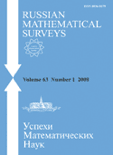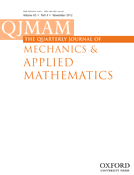
Journal of Rajasthan Academy of Physical Sciences
metrics 2024
Exploring New Dimensions in Physics and Beyond
Introduction
Journal of Rajasthan Academy of Physical Sciences is a prestigious peer-reviewed journal dedicated to advancing knowledge and research in the field of physical sciences. Published by the Rajasthan Academy of Physical Sciences (RAOPS), this journal aims to provide a platform for the dissemination of high-quality research articles, reviews, and case studies that cover a broad spectrum of topics including, but not limited to, physics, applied mathematics, and interdisciplinary studies. While currently operating as a subscription-only journal, it maintains a commitment to fostering academic excellence and collaboration among researchers, professionals, and students. The journal is situated in Jaipur, Rajasthan, and serves as a crucial resource for scholars seeking to share their findings and insights within the scientific community. With its focus on innovation and theoretical advancements, the Journal of Rajasthan Academy of Physical Sciences contributes significantly to the evolving landscape of physical sciences and is designed to engage a diverse readership interested in expanding their knowledge and expertise in this dynamic field.
Metrics 2024
 -
- 0.10
0.10 0.10
0.10 -
-Metrics History
Rank 2024
IF (Web Of Science)
JCI (Web Of Science)
Quartile History
Similar Journals

Applications of Mathematics
Connecting Mathematics to Practical ChallengesApplications of Mathematics, published by SpringerNature, is a respected journal based in the Netherlands that provides a platform for innovative research in the field of applied mathematics. Since its inception in 1997 and with a convergence ongoing until 2024, the journal supports the dissemination of high-quality scholarship, although it currently holds a Q4 category ranking in the applied mathematics category, which reflects its niche importance in the academic community. Researchers and professionals in the field can access a diverse array of applied mathematical techniques and their practical applications, contributing to advancements across various disciplines. While the journal does not operate under an open access model, it is indexed and ranked in Scopus, where it holds a rank of 419 out of 635, placing it in the 34th percentile. This underscores its value and relevance in the global research landscape.

JOURNAL OF BIOLOGICAL PHYSICS
Innovating Insights in Biological PhysicsThe JOURNAL OF BIOLOGICAL PHYSICS, published by Springer, is a premier interdisciplinary journal that focuses on the intersection of biological sciences and physics. With an ISSN of 0092-0606 and an E-ISSN of 1573-0689, this journal serves as a significant platform for researchers and professionals to publish innovative studies, covering fields such as atomic and molecular physics, biophysics, cell biology, and molecular biology. The journal has been a key player since its inception in 1973, showcasing rigorous scientific inquiry and advancing knowledge within these domains, reflected in its categorization in the Q3 and Q4 quartiles of various relevant fields as of 2023. While it currently operates without an Open Access model, the journal continues to provide pivotal contributions to its audience, supporting academic and practical advancements in biological physics while engaging a broad scope of scholarly discourse.

Proceedings of the Estonian Academy of Sciences
Fostering innovation through open-access scholarship.Proceedings of the Estonian Academy of Sciences is a distinguished open-access journal published by Estonian Academy Publishers, dedicated to advancing the interdisciplinary field of sciences with a particular emphasis on engineering. Since its inception in 2006, the journal has been a vital platform for disseminating innovative research findings and developments, making significant contributions to the engineering community. With an impact factor reflective of its scholarly influence and a notable placement in the Q3 category for Engineering (miscellaneous) as of 2023, it attracts submissions from both established researchers and emerging scholars. The journal’s commitment to open access since 2008 ensures that groundbreaking research is freely accessible, fostering collaboration and knowledge exchange globally. Located in Tallinn, Estonia, this journal serves as an essential resource for professionals and students seeking insight into current trends and future directions in engineering.

International Journal of Mathematics and Physics
Advancing Knowledge through Collaborative ScholarshipThe International Journal of Mathematics and Physics, published by AL-FARABI KAZAKH NATIONAL UNIVERSITY, serves as a vital platform for scholars and researchers engaged in the fields of mathematics and physics. With an ISSN of 2218-7987 and E-ISSN 2409-5508, this journal has been committed to disseminating high-quality research since its inception in 2019, and will continue to do so until 2024. Although currently not an open access journal, it provides valuable insights into a diverse array of topics, receiving considerable attention within the academic community. The journal holds a Q4 ranking in categories such as Computer Science Applications, Miscellaneous Mathematics, and Miscellaneous Physics and Astronomy, highlighting its emerging role in these fields. With Scopus rankings placing it at the lower percentiles, the objective of the journal is to foster growth and offer a constructive forum for ideas that will drive innovative research and discussions. The International Journal of Mathematics and Physics is essential for anyone looking to explore the intersections of these disciplines and advance their knowledge through collaborative scholarship.

Mathematics in Engineering
Bridging theory and application in mathematical sciences.Mathematics in Engineering, published by the American Institute of Mathematical Sciences (AIMS), is a premier open-access journal that has been advancing the field of mathematical sciences since its inception in 2019. With a focus on interdisciplinary applications, this journal embraces a broad spectrum of topics within analysis, applied mathematics, and mathematical physics. It has quickly garnered recognition, achieving notable rankings such as Q1 status in Analysis and Mathematical Physics, and Q2 in Applied Mathematics, according to the 2023 category quartiles. The journal’s Scopus rankings further underline its commitment to quality, with impressive placements reflecting its growing influence in the mathematical community. Accessible to all, Mathematics in Engineering aims to provide a platform for the dissemination of innovative research findings and methodologies, fostering collaboration among researchers, professionals, and students in the mathematical domain. For those looking to contribute to or deepen their understanding of current mathematical applications in engineering, this journal is an essential resource.

RUSSIAN MATHEMATICAL SURVEYS
Navigating the complexities of mathematics with clarity.RUSSIAN MATHEMATICAL SURVEYS is a leading scholarly journal published by the Steklov Mathematical Institute of the Russian Academy of Sciences, dedicated to advancing the field of mathematics since its inception in 1970. With an ISSN of 0036-0279 and E-ISSN of 1468-4829, this journal publishes comprehensive surveys and research papers that span a variety of mathematical disciplines, offering insights into new theories and methodologies. Ranked in Q2 of the mathematics category and positioned at the 62nd percentile among general mathematics journals in Scopus, it serves as an essential resource for mathematicians, researchers, and students alike. While it currently does not offer open access options, its significant impact on the mathematical community is reflected in its rigorous publication standards and wide readership. The journal plays a crucial role in disseminating cutting-edge research and promoting mathematical discourse within the global academic community, making it a must-read for anyone invested in the dynamics of modern mathematics.

HERALD OF THE RUSSIAN ACADEMY OF SCIENCES
Illuminating the Intersection of Culture and PoliticsHERALD OF THE RUSSIAN ACADEMY OF SCIENCES is a prominent interdisciplinary journal published by MAIK NAUKA/INTERPERIODICA/SPRINGER, specializing in the fields of cultural studies and political science. With an ISSN of 1019-3316 and an E-ISSN of 1555-6492, this journal features a robust platform for disseminating high-quality research that informs contemporary debates in social sciences. Over its converged years from 2005 to 2024, it has established itself as an influential source of scholarly articles, achieving a Q2 ranking in Cultural Studies and a Q3 ranking in Political Science and International Relations for 2023. The journal is recognized for its valuable contributions, with Scopus ranks reflecting a strong presence in both cultural studies (Rank #444/1304, 65th percentile) and political science (Rank #450/706, 36th percentile). Researchers, professionals, and students seeking to advance their understanding of the societal dynamics at play are encouraged to explore the insightful perspectives offered by this esteemed publication.

Jurnal Fizik Malaysia
Exploring New Frontiers in the Realm of Physics.Jurnal Fizik Malaysia is a prominent academic journal dedicated to advancing the field of physics, published by the esteemed Institut Fizik Malaysia. With an aim to foster knowledge dissemination and research collaboration among physicists, the journal serves as a vital platform for original research articles, reviews, and technical notes that cover various sub-disciplines of physics. Although the journal operates under a traditional subscription model, its commitment to quality has been bolstered by a rigorous peer-review process, ensuring high academic standards. Researchers and students in Malaysia and beyond are encouraged to engage with this journal, contributing to a deeper understanding of physical sciences and its applications. Moreover, with its ISSN 0128-0333, Jurnal Fizik Malaysia continues to play a significant role in the scientific community, enhancing visibility and accessibility for local and international research outputs in the ever-evolving landscape of physics.

QUARTERLY JOURNAL OF MECHANICS AND APPLIED MATHEMATICS
Exploring Complex Phenomena with Precision and Rigor.Quarterly Journal of Mechanics and Applied Mathematics, published by Oxford University Press, stands as a pivotal platform in the realms of applied mathematics, mechanical engineering, and condensed matter physics. Established in 1948, this venerable journal has continuously contributed to advancements in the understanding of complex mechanical phenomena through rigorous research and scholarly articles. With its Q3 status across multiple categories—applied mathematics, condensed matter physics, mechanical engineering, and mechanics of materials—it serves as a significant resource for both emerging and established researchers. While the journal is not open access, it is highly regarded for its selective publication process, ensuring that only high-quality, original research is disseminated. The impact factor reflects its critical role within the academic community, making it an essential read for scholars, professionals, and students aiming to stay at the forefront of developments in mechanics and applied mathematics.

European Journal of Human Movement
Exploring Innovations in Human MotionThe European Journal of Human Movement, published by the University of Extremadura, Faculty of Sports Sciences in Spain, stands as a vital resource within the realms of Health, Physical Therapy, and Social Sciences. With its consistent commitment to Open Access since 2014, the journal facilitates the dissemination of high-quality research, fostering innovation and collaboration among scholars, practitioners, and students alike. The journal has carved out a niche in its categories, being ranked in the Q3 quartile across several fields, including Health (social science) and Physical Therapy, Sports Therapy, and Rehabilitation. With an ongoing publication timeline extending from 2019 to 2024, it aims to highlight contemporary issues, emerging trends, and groundbreaking studies within human movement sciences. Additionally, with its presence in the Scopus ranking and a determination to elevate research standards, the journal remains an essential platform for sharing knowledge and advancing professional practice in a rapidly evolving landscape.